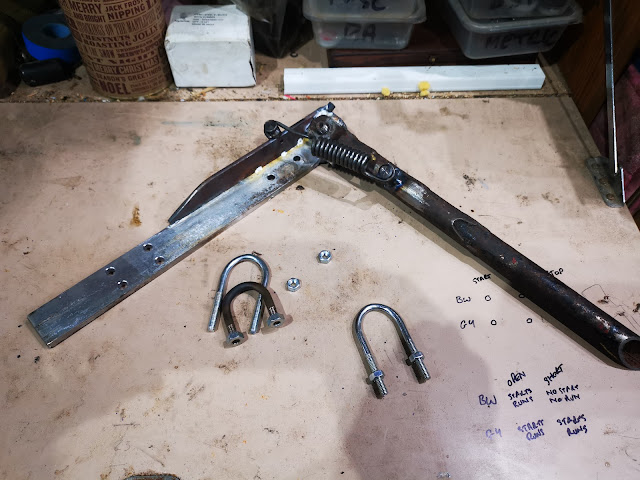The sidestand fitted to Anstey-framed Ariels is a poor affair that does not extend very far from the frame and has a very small foot which combines to make the use of the stand a very precarious and risky operation. I never use it.
However, the bike is a heavy old thing which would benefit from a decent sidestand so in this episode I'll show you how to make one.
I bought a leg, a while back, from eBay. It's from a Suzuki TS125 trail bike, so it is very long and it came with a spring and a M10 x 1.25 bolt. Doing this again, I'd probably buy a Triumph or Enfield leg as I ended up cutting a lot of length off this one.
The sidestand is going to bolt on, but I'm not a fan of clamp on types so this is going to bolt across the two bottom frame rails forward of the sump plate. A piece of steel bar, 6 mm x 35 mm spans the frame. I start by putting a 45° bend in a short length at one end, to start to get an idea of how it will look on the bike and what sort of leg length I will need, where it will sit in the 'up' position and where the stops will need to be. I drill a 10.5 mm hole for the bolt and fit the leg:
The stand is going to be held on the frame rails with three 1/4" U bolts, one on the drive side and two on the timing side. Here's a trial fit of the first one:
With the assembly in place we can look at the leg length, and the angle it is going to make with the ground. Obviously if the stand's touch down point is further away from the bike's centreline, the bike is more stable. We don't want the stand leg too short, but leaving it like this won't allow the bike to lean enough.
Next, we need to stiffen that bar. It's stiff, but this is a heavy machine and we don't want a rider sitting on the bike while it is on the stand opening our stand bracket out. The stiffener is a piece of 20 x 3 mm flat bar
The stiffener also provides somewhere to mount the spring lugs. I made these from a bit of 10 mm round bar on the mini-lathe:
One of the key issues is to get the lugs in the right place such that the spring holds the leg firmly in both positions, without the spring fouling anything as it moves:
There was way too much slop between the stand leg and the mounting bar. I built up the bearing surface with weld and cut it back on the linisher to get it to about 7 mm
It's much less wobbly. Obviously wobble here will affect the lean of the bike when it's on the stand.
Time for another fitting. At the previous trial fit, I marked the position of the timing side U bolts, so now I can drill the holes. I haven't yet trimmed the mounting bracket, but I have trimmed the leg. Here are all the bits:
That's it for now. The stand is back in position and working:
I'll run around with it for a while and see how it goes. I still need to ease the 'u' bolt holes on the timing side and trim the end of the bracket before painting, but for now we need to shake it down.

























